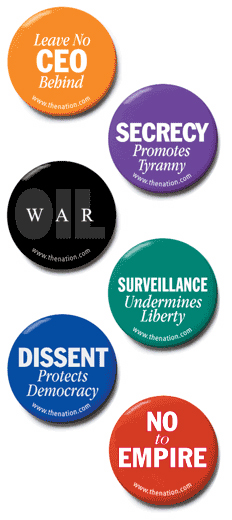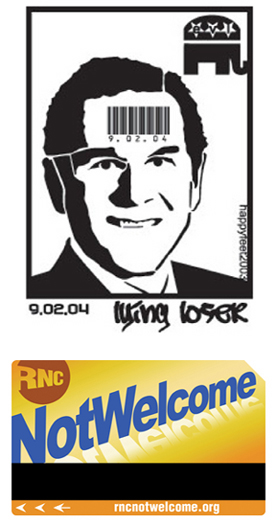There has already been some discussion about the recent AIGA New York Chapter event, Hell Yes! Another Election Another Design Problem. And (hell!) yes, a lot of it was lame. But within the various tactics of the obvious and the rhetoric of the marginalized, there was an extremely valuable lesson in nuance.
First, for readers who weren’t there; a quick, off-the-cuff, and superficial rundown of the participants:
Steve Heller did his Steve Heller thing: an historical survey of American political graphics. Fabulous, but too short.
John Hockenberry acted as moderator (also fabulous) and opened with a lovely rant on how America gets its news from a defense contractor — NBC is owned by General Electric. That little bon mot was followed with the revelation that NBC’s news division’s total budget is approximately one sixth of the value of their contractual interests in Iraq’s rebuilding.
Next came the broad parody of Billionaires for Bush; which is more effective as street theater rather than the 3-song revue we politely sat through. Their inhabitation of the billionaire persona isn’t refined enough to be isolated on stage — a strange paradox for what seems to be a bunch of actors. The clothing is a thrift shop version of fancy ball dress, not the everyday khaki of a Bill Gates; they puff puff puff the cigars a bit too enthusiastically; and the rhetoric pretty much stops at their name. More caricature than anything else.
Liz Winstead presented a series of advertisements for Air America, superimposing the print ads designed by No. 17 with corresponding radio spots. The radio ads were typically inflammatory and the print ads have already been better covered by Michael Bierut on Design Observer. I really like the posters, but nothing new here.
A big disappointment was Rob Corddry, who showed a long clip of The Daily Show’s Super Tuesday coverage; the night John Kerry was tapped as Democratic party candidate. Other than a few sarcastic remarks on the panel, that was it. Now I like The Daily Show; watch it every night. But he wasn’t really there. Thanks for participating. Good night.
I’ve never been a big fan of Tom Tomorrow’s cartoons. The humor’s obvious, and the visual look is a watered-down detournment — the Situationists did it first, did it better — the result of his use of facts and quotes. One gets the feeling that his need to inform overpowers his abilities to transform the material; probably why I find his blog to be more compelling.
For myself and pretty much every other attendant I’ve spoken to, the best thing about the evening was Milton Glaser. Wise, sensitive, compelling — without rancor, without mindless rhetoric, without all the things that I’ve come to despise about American political discourse.
Starting with the I (heart) NY logo, he described how something he considered so undesigned, so null, became a cultural phenomena in spite of his offhanded disregard. Over the thirty years of the logo’s life, he gained the realization that sometimes you don’t really need graphic cleverness. (A shocking statement for Speak Up’s recliners of logo rage) He then presented some rather dull buttons done for The Nation.

No, not the most exciting graphics, but a couple of them are more thought provoking than these T-shirts from RNCnotwelcome.org:

The crude portrayal of the despised figure, the ironic appropriation of the symbolic object; we have all seen this. I admit to using extremes to make my point, but it’s extremes like this that describe why Air America, Tom Tomorrow, and Billionaires for Bush leave me tepid about political activism. And I’m an involved guy: President of the Condo Board, know all my elected officials, attend Community Board & City Council meetings, letters to City departments… you know the type. I’m just not a screamer.
And the one pervasive aspect of American political discourse is the screaming. Whether Ann Coulter or Janeane Garofalo, red state or blue state; once they hit shrill, I cringe. I’ll be dammed before I march with any of them; not because of their politics, but because of their damn smugness. The designers, illustrators & artists currently squirreled away in their studios, preparing for the Republican National Convention in NYC, are probably working on this very brand of marginalized agitprop. If you want to see the results, watch the news in September. When they show all the protesters, look in front of the oversized puppets.
As Milton said on Tuesday, the side that succeeds in lowering the rhetorical temperature stands a good chance of cutting through all the noise of protest. Basically, “it’s a design problem”.
Given the certainty of protests in New York City this summer, and given the possibility of bloody clashes between police and marchers; Milton unveiled a proposal for an alternative, non-confrontational protest: Light Up the Sky. It will make it’s public debut in an upcoming issue of The Nation and calls for all those opposed to the current administration to make a silent statement with light the evening of August 30: leaving lights on, gathering together in the streets with candles and flashlights, etc.
The thought of thousands of Diogenes, hoping for an honest man, instantly gave me chills. It is simple, elegant and repurposes the spontaneous displays in the streets of lower Manhattan immediately after 9/11. It avoids the issue of sanctioned protest areas (an idiotic euphemism), it is non-violent, and it speaks to community rather than divisiveness.
So, to all the designers preparing for the Republican National Convention, please consider a nuanced persuasion over expressionist screed, over sarcastic irony, over spat-out bile. One should avoid quoting Rumi, but in this case… Sell your cleverness and buy bewilderment. Cleverness is mere opinion. Bewilderment brings intuitive knowledge.










I thought the event would have been better had the presentations been eliminated or shortened in favor of more Q and A. It seemed that most everyone there would be familiar with The Daily Show, Tom Tomorrow, and Air America and the overviews of their work was unnecessary. I would have preferred prepared comments that spoke specifically to the topic of the night. Milton Glaser's presentation on the other hand was very good.
Only one question from the audience was taken besides those on the cards. I was going to ask something along the line of this, but never got a chance:
I feel that it's not a matter of effective design or branding that has kept both parties so prominent but rather advertising and the media barrage of talking points. A campaign sign or bumper sticker for either is so similar in type / color / placement as to be indistinguishable except for the content, so I don't think there is any branding of either party to sell their party to the people. Is it possible for a third party with good (and different) design to become viable, or is this a fight that they will have to win by slugging away with ungodly amounts of money in advertising - something they don't seem able to do.
What will it take for a third party to bring change to the political climate? Is design enough to solve this problem, or is there more to it than that?
Also, a question for anyone that remembers:
Are Milton Glaser's 'W' pins available now or are they coming soon? I saw the other series on thenation.com's page but not those.
On Jun.11.2004 at 08:15 AM